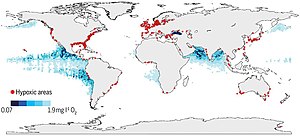
| Part of a series on |
| Pollution |
|---|
 |
Hypoxia (hypo: "below", oxia: "oxygenated") refers to low oxygen conditions. Hypoxia is problematic for air-breathing organisms, yet it is essential for many anaerobic organisms. Hypoxia applies to many situations, but usually refers to the atmosphere and natural waters.[3]
- ^ Breitburg, D., Levin, L. A., Oschlies, A., Gregoire, M., Chavez, F. P., and Conley, D. J. (2018) "Declining oxygen in the global ocean and coastal waters". Science, 359: eaam7240. doi:10.1126/science.aam7240.
- ^ Benway, H.M., Lorenzoni, L., White, A.E., Fiedler, B., Levine, N.M., Nicholson, D.P., DeGrandpre, M.D., Sosik, H.M., Church, M.J., O'Brien, T.D. and Leinen, M. (2019) "Ocean time series observations of changing marine ecosystems: an era of integration, synthesis, and societal applications", Frontiers in Marine Science, 6(393). doi:10.3389/fmars.2019.00393.
- ^ Cite error: The named reference
Diazwas invoked but never defined (see the help page).